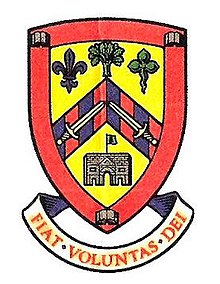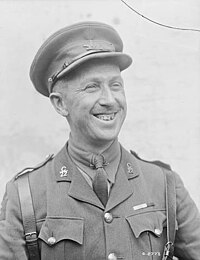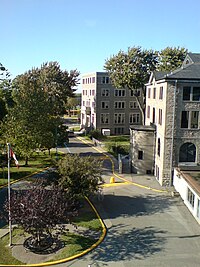Vanier College
This article needs additional citations for verification. (October 2007) |
45°30′52.27″N 73°40′30.00″W / 45.5145194°N 73.6750000°W
 | |
| Motto | Fiat Voluntas Dei |
|---|---|
Motto in English | God's will be done |
| Type | College |
| Established | 1970 |
| President | Normand W. Bernier |
| Dean | Danielle Lafaille |
| Students | 6100 |
| Undergraduates | pre-university students; technical |
| Address | 821 Ste. Croix, Montreal, Quebec, Canada H4L 3X9 , , , |
| Campus | Urban |
| Sports team | Cheetahs |
| Colours | Red and Gold |
| Affiliations | ACCC, CCAA, QSSF |
| Mascot | Cheetah |
| Website | vaniercollege.qc.ca |
 | |
Vanier College is an English-language public college located in the Montreal borough of Saint-Laurent, Quebec, Canada. It was founded in 1970 as the second English-language public college of Quebec's public college system, after Dawson College. Vanier is located just north of CEGEP Saint-Laurent, a French-language public college.
Programs
Vanier College offers over twenty-five programs of study in both two-year pre-university and three-year technical fields.[1] With a student population averaging six thousand, Vanier College is the third-largest English-language college in Québec. The college offers two types of programs: pre-university and technical. The pre-university programs, which take two years to complete, cover the subject matters which roughly correspond to the additional year of high school given elsewhere in Canada in preparation for a chosen field in university. Students graduating from a college program are prepared more adequately for university studies.[2] The technical programs, which take three years to complete, applies to students who wish to be career-ready; however, many students choose to pursue a university degree. In addition, the Continuing Education Centre offers a wide variety of credit courses and programs with flexible scheduling.
Pre-university programs
- Commerce
- Communications: Art, Media, Theatre
- Computer Science and Mathematics
- Liberal Arts
- Modern Languages
- Modern Languages and Music Double DEC
- Music
- Science
- Science and Music Double DEC
- Science and Social Science Double DEC (Commerce Option)
- Social Science
- Social Science Majors (law and society, child studies, international studies,psychology,sports and leisure studies)
- Social Science and Music Double DEC
Usually, pre-university programs require four semesters (two years) to complete. Exceptions include the Double DEC programs, which require six semesters (three years) to complete.
Technical/Career programs
- Animal Health Technology
- Architectural Technology
- Building Systems Engineering Technology
- Business Administration
- Computerized Systems Technology
- Computer Science Technology
- Early Childhood Education
- Environmental and Wildlife Management
- Industrial Electronics
- Nursing
- Office Systems Technology: Micropublishing and Hypermedia
- Professional Music and Song Techniques
- Respiratory and Anaesthesia Technology
- Special Care Counselling
Usually, technical and career programs require six semesters (three years) to complete.
Partnerships
The College of General and Professional Education is affiliated with the Association of Canadian Community Colleges (ACCC) and Canadian Colleges Athletic Association (CCAA).
Athletics
The college participates as the Vanier Cheetahs in the Canadian Colleges Athletic Association, and is known for its men's and women's basketball and football (soccer) teams, men's rugby union and Canadian football teams, and women's flag football teams.
History

Vanier College was named in honour of Georges Vanier, Canada's second native-born Governor General.
Before Vanier (1817-1970)
Vanier College today consists of 10 different buildings on a single campus. Each of its buildings was built at a different point in the college's history, and is identified by a letter of the alphabet.
The land that the campus is located on today was first used for the Village de Saint-Laurent chapel, opened in 1817. Thirty years later, a convent, known as the Couvent Notre-Dame-des-Anges, was built nearby by the Sisters of Holy Cross (fr: Sœurs de Sainte-Croix[3]). The original Convent building was later expanded into the building known as the "C building" today. [1]
In 1897, the sisters opened the first college on the campus land, on the location of today's "E building". That building was expanded in 1848 and 1857 to become today's "E building".[2] In 1873, a chapel was built that connected the convent and college buildings. That chapel was a forerunner of today's "F building".[3] The "B building" was a further expansion of the convent built on the north side of the "C building" in 1904. It was unclear exactly when the "D building" was built, but it appears to have been at around this same time. The "D building" connected to the rear (east side) of the original "F building" chapel.
Originally, both the "D" and "E" buildings had elaborate balconies on every floor, which were removed in the 1970s. This is why several windows on both buildings today are taller than the rest of the windows in the building - these windows were doors to the balconies in the original building design.[4]
In 1911, the original Village de Saint-Laurent chapel was demolished, to be replaced by a new school for young girls, Académie Saint-Alfred. The cupola at the top of the new building was designed to reflect a similar cupola on the original chapel building. This new building eventually became Vanier's "H building".[5]
In 1933, the Sisters opened the yet another college, Collège Basile-Moreau, within the existing convent buildings. This soon required further expansions to the campus. In the 1940s, the "A building" was built at the north end of the "B building".[6]
In the 1950s, the original "F building" chapel was demolished and replaced with the building that stands as the "F building" today. In 1967, several institutions were merged and became public ones, when the Quebec system of CEGEPs was created.
Since becoming Vanier (1970-present)

In 1970, the Quebec government purchased the entire property and it was re-opened as Vanier College, Quebec's second English language public college (after Dawson College that had opened the year previous). Enrollment in its first year was approximately 1,400 students.[7]
- Even though the library has three floors, it can only be entered via its first floor.
- The oldest of the main building sections is the "E building".
- It has been agreed upon that getting from any one room to another takes under ten minutes, within the boundaries of the campus.
Notable alumni
- Jabari Arthur, wide receiver for the CFL
- Tim Biakabutuka, former NFL player
- Russell Copeman, politician
- David De La Peralle, former offensive lineman in the CFL
- Farell Duclair, Canadian football player
- Otis Grant, one-time boxing world champion
- Yolande James, first black woman elected to the provincial legislature
- Patrick Kabongo, offensive lineman for the CFL Edmonton Eskimos
- Elias Koteas, actor
- Paul Lambert, CFL player for Hamilton Tiger-Cats and Montreal Alouettes
- Robert Libman, politician
- John Moore, radio and television broadcaster who currently works on CFRB
- Thomas Mulcair, Leader of the Official Opposition in Canada, leader of the NDP, a lawyer, university professor, and politician
- Andy Nulman, co-founder of "Just for Laughs" comedy festival
- Karine Sergerie, Olympic silver medalist
- Mutsumi Takahashi, full-time co-anchor for CFCF News
- Frédérique Vézina, opera singer
- Andrew Walker, actor
- Patrick Watson, indie rock musician
- Steven Woloshen, pioneer of hand-made experimental films
- Steve Zatylny, Canadian football player
Notable staff
- Errol Sitahal, writer, director, filmmaker and actor, taught at Vanier College in the 1970s
- Keith Henderson, politician, former Equality Party leader
- Dr. Joe, Joe Schwarcz, science popularizer, former chemistry teacher
- Ariel Fenster, science popularizer, former chemistry teacher
- Gordon Edwards, mathematics, President and Co-Founder of the Canadian Coalition for Nuclear Responsibility
- Martine Dugrenier, Former world champion in women's wrestling
See also
Other English-language Colleges:
References
External links
- Vanier College
 Media related to Vanier College at Wikimedia Commons
Media related to Vanier College at Wikimedia Commons
